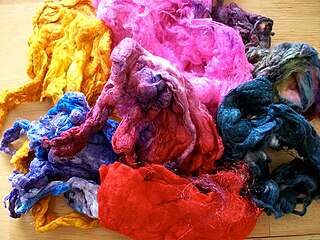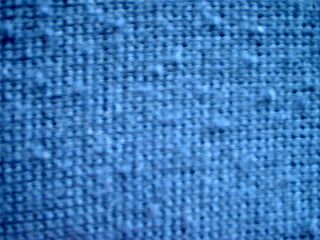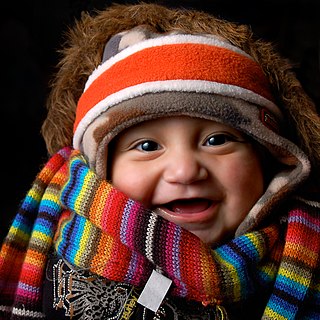Related Research Articles
Spinning is a twisting technique to form yarn from fibers. The fiber intended is drawn out, twisted, and wound onto a bobbin. A few popular fibers that are spun into yarn other than cotton, which is the most popular, are viscose, animal fibers such as wool, and synthetic polyester. Originally done by hand using a spindle whorl, starting in the 500s AD the spinning wheel became the predominant spinning tool across Asia and Europe. The spinning jenny and spinning mule, invented in the late 1700s, made mechanical spinning far more efficient than spinning by hand, and especially made cotton manufacturing one of the most important industries of the Industrial Revolution.

Textile is an umbrella term that includes various fiber-based materials, including fibers, yarns, filaments, threads, different fabric types, etc. At first, the word "textiles" only referred to woven fabrics. However, weaving is not the only manufacturing method, and many other methods were later developed to form textile structures based on their intended use. Knitting and non-woven are other popular types of fabric manufacturing. In the contemporary world, textiles satisfy the material needs for versatile applications, from simple daily clothing to bulletproof jackets, spacesuits, and doctor's gowns.

Yarn is a long continuous length of interlocked fibres, used in sewing, crocheting, knitting, weaving, embroidery, ropemaking, and the production of textiles. Thread is a type of yarn intended for sewing by hand or machine. Modern manufactured sewing threads may be finished with wax or other lubricants to withstand the stresses involved in sewing. Embroidery threads are yarns specifically designed for needlework. Yarn can be made of a number of natural or synthetic materials, and comes in a variety of colors and thicknesses. Although yarn may be dyed different colours, most yarns are solid coloured with a uniform hue. Yarn can be used to make clothing and many other kinds of artworks using a wide variety of techniques and materials.

Velvet is a type of woven tufted fabric in which the cut threads are evenly distributed, with a short, dense pile, giving it a distinctive soft feel. By extension, the word velvety means "smooth like velvet". In the past, velvet was typically made from silk. Today, velvet can be made from linen, cotton, wool and synthetic fibers.

Worsted is a high-quality type of wool yarn, the fabric made from this yarn, and a yarn weight category. The name derives from Worstead, a village in the English county of Norfolk. That village, together with North Walsham and Aylsham, formed a manufacturing centre for yarn and cloth in the 12th century, when pasture enclosure and liming rendered the East Anglian soil too rich for the older agrarian sheep breeds. In the same period, many weavers from the County of Flanders moved to Norfolk. "Worsted" yarns/fabrics are distinct from woollens : the former is considered stronger, finer, smoother, and harder than the latter.

Dyeing is the application of dyes or pigments on textile materials such as fibers, yarns, and fabrics with the goal of achieving color with desired color fastness. Dyeing is normally done in a special solution containing dyes and particular chemical material. Dye molecules are fixed to the fiber by absorption, diffusion, or bonding with temperature and time being key controlling factors. The bond between dye molecule and fiber may be strong or weak, depending on the dye used. Dyeing and printing are different applications; in printing, color is applied to a localized area with desired patterns. In dyeing, it is applied to the entire textile.

Noil refers to the short fibers that are removed during the combing process in spinning. These fibers are often then used for other purposes.

Textile manufacturing is a major industry. It is largely based on the conversion of fibre into yarn, then yarn into fabric. These are then dyed or printed, fabricated into cloth which is then converted into useful goods such as clothing, household items, upholstery and various industrial products.
The manufacture of textiles is one of the oldest of human technologies. To make textiles, the first requirement is a source of fiber from which a yarn can be made, primarily by spinning. The yarn is processed by knitting or weaving, which turns yarn into cloth. The machine used for weaving is the loom. For decoration, the process of colouring yarn or the finished material is dyeing. For more information of the various steps, see textile manufacturing.

In clothing, heather refers to a color effect created by mixing two or more different colored fibers or yarns. It is interwoven yarns of mixed colors, and possibly the type of fiber, producing another color. It is typically used to mix multiple shades of grey or grey with another color to produce a muted shade, but any two colors can be mixed, including bright colors. A mixed fabric color is achieved by using different colors of fiber and mixing them together. Black and white fiber mixed will combine to give grey heather fiber. Heather is blended fibers combined to create a multicolored effect. Heather effect is also known as melange effect.
A staple fiber is a textile fiber of discrete length. The opposite is a filament fiber, which comes in continuous lengths. Staple length is a characteristic fiber length of a sample of staple fibers. A fiber is made up of natural substances and is known for being longer than it is wide. It is an essential criterion in yarn spinning, and aids in cohesion and twisting. Compared to synthetic fibers, natural fibers tend to have different and shorter lengths. The quality of natural fibers like cotton is categorized on staple length such as short, medium, long staple, and extra-long. Gossypium barbadense, one of several cotton species, produces extra-long staple fibers. The staple fibers may be obtained from natural and synthetic sources. In the case of synthetics and blends, the filament yarns are cut to a predetermined length.

Novelty yarns include a wide variety of yarns made with unusual features, structure or fiber composition such as slubs, inclusions, metallic or synthetic fibers, laddering and varying thickness introduced during production. Some linens, wools to be woven into tweed, and the uneven filaments of some types of silk are allowed to retain their normal irregularities, producing the characteristic uneven surface of the finished fabric. Man-made fibres, which can be modified during production, are especially adaptable for special effects such as crimping and texturizing.

In textile manufacturing, finishing refers to the processes that convert the woven or knitted cloth into a usable material and more specifically to any process performed after dyeing the yarn or fabric to improve the look, performance, or "hand" (feel) of the finish textile or clothing. The precise meaning depends on context.

A pill, colloquially known as a bobble, fuzzball, or lint ball, is a small ball of fibers that forms on a piece of cloth. Pill is also a verb for the formation of such balls.
Wet Processing Engineering is one of the major streams in Textile Engineering or Textile manufacturing which refers to the engineering of textile chemical processes and associated applied science. The other three streams in textile engineering are yarn engineering, fabric engineering, and apparel engineering. The processes of this stream are involved or carried out in an aqueous stage. Hence, it is called a wet process which usually covers pre-treatment, dyeing, printing, and finishing.
Bourette is a silk fabric with bumps often blended with other yarns made of Bourette fibers. The name "Bourette" is from its constituting fiber. It has a rough surface incorporating multicolored threads and knots of spun silk. The fabric is made with silk bourette and wool or cotton yarn. Bourette is a lightweight single cloth with a rough, knotty, and uneven surface.

Hand feel is the property of fabrics related to the touch that expresses sensory comfort. It refers to the way fabrics feel against the skin or in the hand and conveys information about the cloth's softness and smoothness. Hand feel is an estimated and subjective property of different fabrics, but nowadays, hand feel could be measured and assessed statistically.

Scouring is a preparatory treatment of certain textile materials. Scouring removes soluble and insoluble impurities found in textiles as natural, added and adventitious impurities, for example, oils, waxes, fats, vegetable matter, as well as dirt. Removing these contaminants through scouring prepares the textiles for subsequent processes such as bleaching and dyeing. Though a general term, "scouring" is most often used for wool. In cotton, it is synonymously called "boiling out," and in silk, and "boiling off."
Deweighting, deweighing or weight reduction, is a chemical treatment that peels the surface of polyester fibers and makes them softer and finer. It also reduces the fiber weight and hence weakens the strength. Additionally, the treatment enhances the absorbency of the treated substrates. Deweighting is an alkaline hydrolysis treatment that affects the surface fibers of the polyester and reduces the decitex or denier of fibers, weight loss of between 10% and 30% is possible during the treatment. Polyester and cotton blends can be treated with an alkali process to make them look and feel like silk.

Dead cotton is a term that refers to unripe cotton fibers that do not absorb dye. Dead cotton is immature cotton or underdeveloped cotton that has poor dye affinity and appears as white specks on a dyed fabric. Daniel Koechlin (1785–1871), who was a manufacturer and a chemist in Mulhouse, established the fact in 1848 that it is dead cotton fibers that resist dye. Other chemists such as Walter Crum, Albin Haller, and Herzog explored and contributed to the subject further. Crum discovered that dead fibers have very thin cell walls.
References
- 1 2 3 4 5 6 7 8 9 10 11 Hollen, Norma Rosamond (1979). Textiles. Internet Archive. New York : Macmillan. p. 143. ISBN 978-0-02-356130-6.
- ↑ Barnett, Anne (1997). Examining Textiles Technology. Heinemann. p. 51. ISBN 978-0-435-42104-5.
- 1 2 3 "blending | yarn manufacturing | Britannica". www.britannica.com. Retrieved 2022-01-02.
- ↑ Kadolph, Sara J. (1998). Textiles. Internet Archive. Upper Saddle River, N.J. : Merrill. p. 402. ISBN 978-0-13-494592-7.
- ↑ Fairchild's dictionary of textiles. Internet Archive. New York, Fairchild Publications. 1959. p. 355.
{{cite book}}: CS1 maint: others (link) - ↑ Montgomery, Florence M. (1984). Textiles in America 1650-1870 : a dictionary based on original documents, prints and paintings, commercial records, American merchants' papers, shopkeepers' advertisements, and pattern books with original swatches of cloth. Internet Archive. New York ; London : Norton. p. 369. ISBN 978-0-393-01703-8.
- ↑ Indian Journal of History of Science. National Institute of Sciences of India. 1982. pp. 120, 128.
- ↑ Rutnagur, Sorabji M. (1985). The Indian Textile Journal. Business Press. p. 54.
- ↑ Rutnagur, Sorabji M. (1985). The Indian Textile Journal. Business Press.
- ↑ Crill, Rosemary (2006). Textiles from India: The Global Trade : Papers Presented at a Conference on the Indian Textile Trade, Kolkata, 12-14 October 2003. Seagull Books. p. 331. ISBN 978-1-905422-17-3.
- ↑ Montgomery, Florence M. (1984). Textiles in America 1650-1870 : a dictionary based on original documents, prints and paintings, commercial records, American merchants' papers, shopkeepers' advertisements, and pattern books with original swatches of cloth. Internet Archive. New York ; London : Norton. p. 347. ISBN 978-0-393-01703-8.
- 1 2 Wingate, Isabel Barnum (1976). Textile fabrics and their selection. Internet Archive. Englewood Cliffs, N.J. : Prentice-Hall. p. 18. ISBN 978-0-13-912840-0.
- ↑ Joseph, Marjory L. (1992). Joseph's introductory textile science. Internet Archive. Fort Worth : Harcourt Brace Jovanovich College Publishers. pp. 73, 74. ISBN 978-0-03-050723-6.
- 1 2 Collier, Billie J. (2009). Understanding textiles. Internet Archive. Upper Saddle River, N.J. : Pearson Prentice Hall. p. 71. ISBN 978-0-13-118770-2.
- ↑ Miao, Menghe; Xin, John H. (2017-09-07). Engineering of High-Performance Textiles. Woodhead Publishing. p. 63. ISBN 978-0-08-101885-9.
- ↑ Denton, Michael James; Daniels, Paul N. (2002). Textile Terms and Definitions. Textile Institute. p. 255. ISBN 978-1-870372-44-2.
- ↑ Wardman, Roger H. (2017-09-20). An Introduction to Textile Coloration: Principles and Practice. John Wiley & Sons. ISBN 978-1-119-12158-9.
- ↑ heddels. "Heather". Heddels. Retrieved 2022-01-03.
- ↑ Wardman, Roger H. (2017-09-20). An Introduction to Textile Coloration: Principles and Practice. John Wiley & Sons. p. 382. ISBN 978-1-119-12158-9.
- ↑ Townsend, Terry (2005-10-30). Cotton Trading Manual. Elsevier. p. 57. ISBN 978-1-84569-092-2.
- ↑ Collier, Billie J. (2009). Understanding textiles. Internet Archive. Upper Saddle River, N.J. : Pearson Prentice Hall. p. 104. ISBN 978-0-13-118770-2.
- ↑ Das, Dipayan; Pourdeyhimi, Behnam (2014-03-14). Composite Nonwoven Materials: Structure, Properties and Applications. Elsevier. p. 99. ISBN 978-0-85709-775-0.